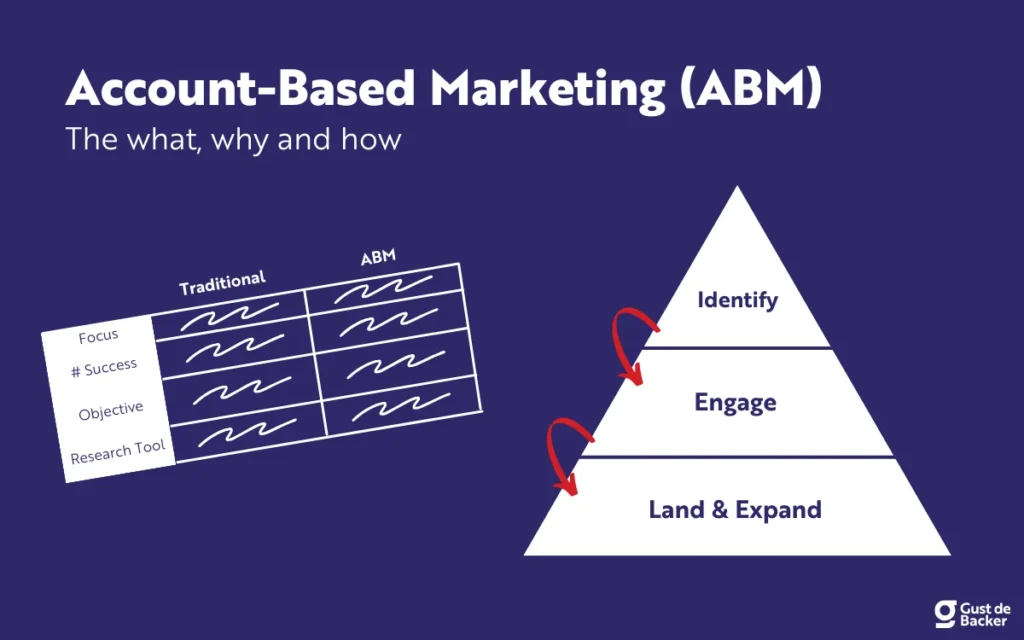Table of Contents
Here’s the honest truth—most marketing feels like a shot in the dark.
You write blogs, run ads, post on social media, send emails, and cross your fingers hoping the right people see it. Sometimes it works. Most of the time? It feels like throwing spaghetti at the wall.
But what if you stopped trying to market to everyone and instead focused only on the companies that truly matter to your business?
That’s exactly what account-based marketing (ABM) helps you do.
It’s not about reaching more people—it’s about reaching the right people, with messages that actually mean something to them.
What is Account-Based Marketing?
Let’s keep this simple.
Account-based marketing is a strategy where you pick a few high-value companies you really want as clients, and then create marketing just for them. You don’t try to reach thousands of random people. You focus on a few great-fit companies and speak directly to their needs.
So instead of shouting into a crowded room, you’re sitting down across the table from someone and having a real, meaningful conversation.
That’s the heart of ABM.
Why Account-Based Marketing Just Makes Sense
ABM isn’t some trendy marketing buzzword. It works—especially if you sell B2B and your deals involve long sales cycles or multiple decision-makers.
Here’s why it clicks:
You Focus on the Right People
Stop pouring time and money into leads that never go anywhere. With account-based marketing, you go after companies that are actually a good fit—and worth the effort.
It Feels Personal (Because It Is)
Nobody likes being treated like just another name on a list. ABM allows you to personalize your message for each company, sometimes even down to individual roles like the CMO or CTO.
Marketing and Sales Finally Work Together
In traditional marketing, teams often work in silos. With ABM, sales and marketing finally get on the same page—working toward the same goals, targeting the same accounts. That teamwork? Game-changing.
You Get More Bang for Your Buck
It may take more effort per account, but ABM usually delivers a higher return on investment. Because instead of a bunch of cold leads, you’re working with warm, targeted prospects.
How to Actually Do Account-Based Marketing
If you’re thinking, “Okay, this sounds great—but how do I even start?”, don’t worry. It’s not complicated. Here’s a breakdown:
1. Pick Your Dream Accounts
Make a list of companies you’d love to work with. These are high-value, ideal-fit clients. Maybe they’re in a specific industry, have a certain number of employees, or you just know you can solve their problem.
2. Research the People Inside Those Companies
Now that you know who you want, it’s time to figure out who to talk to. Is it the marketing director? The COO? Learn their roles, challenges, goals—anything that helps you understand what they care about.
3. Create Personalized Campaigns
Use what you know to speak their language. Send them content that actually helps—like a case study, short video, or tailored email. Don’t pitch. Add value first. Show them you’ve done your homework.
4. Align Your Sales and Marketing Team
ABM only works when sales and marketing are on the same page. Marketing warms up the account, sales takes the conversation deeper. It’s a tag team, not a relay race.
5. Track and Tweak
Pay attention to what’s working—what content are they engaging with? Are they booking calls? What’s moving them forward? Use that insight to get even better.
ABM in Real Life: A Simple Example
Let’s say you offer a project management tool made for remote teams. You could blast ads on social media and hope for sign-ups… or you could do this:
You pick 10 remote-first companies. You learn what tools they use, how big their teams are, and who leads operations.
Then, you send a personalized message to the head of ops at each company with a short video explaining how your tool saved a similar business 20 hours a week.
Boom. That’s account-based marketing—real, specific, and way more effective than a cold ad.
ABM vs Traditional Marketing: What’s the Difference?
Still wondering how ABM stacks up to the usual approach? Here’s a quick breakdown:
| Traditional Marketing | Account-Based Marketing |
|---|---|
| Broad targeting | Focused, account-specific |
| One-size-fits-all messaging | Highly personalized |
| High volume, low relevance | Low volume, high relevance |
| Marketing works alone | Marketing + Sales collaborate |
| Long, uncertain funnel | Shorter, more predictable path |
Types of Account-Based Marketing (Pick What Works)
You don’t have to go all-in at once. ABM comes in different levels:
One-to-One ABM
You target a single account with a fully customized campaign. Ideal for big deals.
One-to-Few ABM
You group 5–10 similar companies and create slightly tailored content for them.
One-to-Many ABM
You use data and automation to target a larger group with relevant messaging. Less personal, but still focused.
Whichever you choose, it’s still account-based marketing—just scaled to fit your team.
Do You Need Fancy Tools? Not Really.
Sure, tools like HubSpot, Demandbase, or LinkedIn Ads can help with account-based marketing, but they’re not required to start. You can get rolling with just:
- A spreadsheet
- A CRM (even a free one)
- An email account
- Some creativity and effort
Don’t let tech hold you back. ABM is more about thinking differently than spending big.
What to Avoid (So You Don’t Waste Time)
Let’s quickly cover what not to do:
- Don’t go after companies just because they’re big. Focus on fit first.
- Don’t send the same email to everyone. Personalization is key.
- Don’t let sales and marketing do their own thing. ABM needs teamwork.
- Don’t set it and forget it. Check what’s working and keep improving.
Final Thoughts: ABM is Just Smart Marketing
Here’s the deal—account-based marketing isn’t complicated. It’s just focused, personal, and smart.
It’s about knowing who your best clients are and giving them a reason to care about what you do. And honestly? That’s what marketing should have been all along.
So if you’re tired of chasing leads that don’t go anywhere, maybe it’s time to slow down, get focused, and build something that actually works.
Start with a list of 5 dream clients. Reach out with purpose. Show them you understand their world. And go from there.
One great account is worth more than 100 cold leads. That’s the ABM difference.

